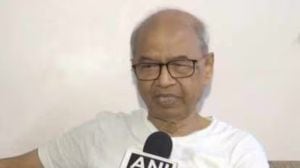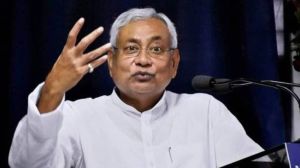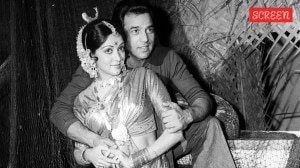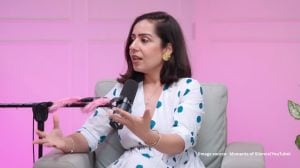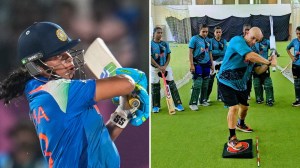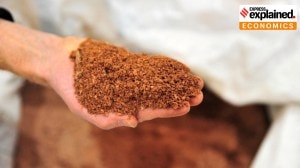
But the tag of “appeasement” seems to have stuck, and the BJP has been quick to cash in on the Hindu angst over “discrimination”. This change is visible on the ground — in the once uncommon Jai Shri Ram greeting now heard on roads and in markets; in buildings marked ‘Satsang’, not a very familiar concept in rural Bengal; in the Ram Navami celebrations, that were once only concentrated in the Hindi-speaking areas of Howrah. The last two years, the VHP has taken out at least 800-1,000 Ram Navami rallies across Bengal, many of them led by BJP leaders, including state chief Dilip Ghosh. In the run-up to the general elections, spread out in Bengal over all the seven phases (April 11 to May 19), except its two Muslim candidates (Humayun Kabir, Murshidabad, and Mafuja Khatun, Jangipur), the rest of the BJP’s 40 candidates have all participated in Ram Navami rallies this year (April 13, 14).
Story continues below this ad
‘A vote for Modi’
In the 2014 Lok Sabha polls, the BJP had got just two two seats to the Trinamool’s 34. However, even that marked a jump in vote share from 6.47% in 2009 to 17.02%. While in the 2016 Assembly elections, this had fallen to 10.2%, it is really the BJP’s performance in last year’s panchayat elections, despite allegations of Trinamool rigging, that is the wind beneath its sails in these Lok Sabha polls. With about 18% votes, the BJP had emerged as the main opposition party, ahead of the Congress and Left.
 PM Modi addressing a rally at Cooch Behar Rasmela ground. (Express photo by Partha Paul)
PM Modi addressing a rally at Cooch Behar Rasmela ground. (Express photo by Partha Paul)
The rise coincides with a series of communal incidents in Bengal since 2016, including the burning of a police station at Kaliachowk; clashes at Ilambazar in Birbhum and Hazinagar in North 24 Parganas; the communal clash in Dhulagarh, Howrah; violence over Durga Puja immersions and Muharram processions in 2017; riots the same year in North 24 Parganas over a Facebook post; and clashes in March 2018 in Asansol surrounding Ram Navami marches.
“I like Modi. The way he talks, walks, everything… It is difficult to explain why one likes someone. Yes, I liked that he attacked Pakistan but also that he thinks about poor people like us. He is on his own, he does not change sides, he is not with one party one day and another party another day,” says Sukhlal Mondol, a plumber in Malda North.
Remind him that his local BJP candidate, Khagen Murmu, is actually a party hopper — Murmu was a Left MLA — he gives an embarrassed laugh. But it is not something that will weigh on his mind when he presses the EVM button. “My vote is to strengthen Modi,” he says, echoing a line that is seen in the BJP wall graffiti here — “Vote for Khagenda to strengthen Modi’s hand”.
Story continues below this ad
 PM Narendra Modi arrives at Rasmela ground, Cooch Behar for a BJP election rally. (Express photo by Partha Paul)
PM Narendra Modi arrives at Rasmela ground, Cooch Behar for a BJP election rally. (Express photo by Partha Paul)
And if the BJP undercurrent is subterranean, it is by choice, not chance. Anil Sharma, a second-generation West Bengal resident originally from Bihar, says: “In every BJP meeting, they tell us if they beat you up for holding BJP flags, do not retaliate. If they ask you to participate in rallies, do it. But on D-day, vote for us,” he says. Sharma is a voter in South Kolkata, a seat where a BJP victory is unthinkable.
This was once the Trinamool’s copyright tactic against the Left — “Chupchap, phoole chhap (Quietly, vote for the flower, the Trinamool symbol)” used to be the refrain then. Now it means a different flower.
With almost 50 per cent of its voters Muslim, neither of the two Malda seats — Maldaha Dakshin and Maldaha Uttar — are automatic BJP focal points. But the strong Hindu polarisation is giving the saffron party hope and the Trinamool jitters, especially Maldaha Uttar, where the latter has poached Mausam Noor, the sitting Congress MP and niece of the region’s tallest Congress leader A B A Ghani Khan Chowdhury. That is why the pitch of the Left Front, which has fielded a Hindu candidate like the BJP, in Biswanath Ghosh, to voters is:
“Don’t vote for us but don’t choose the traitor”. The implication is clear — vote for the Congress, a sign that even though the Congress-Left alliance did not happen, in some seats the two are still working in tandem. Congress candidate Isha Khan is also a relative of the late Ghani Khan.
The efforts towards a Left-Congress alliance crashed because of disagreement over two seats, Murshidabad and Raiganj, currently held by the Left. According to Abdul Mannan, the leader of the opposition in the state Assembly, in the meeting with Congress president Rahul Gandhi, the entire party organisation in the state spoke in favour of an alliance “except the two people who will fight the elections”. The reference is to former PCC president Adhir Chowdhury and former Union minister Deepa Dasmunsi. While Dasmunsi is fighting from Raiganj, Chowdhury is known to be the boss of Murshidabad, though his own seat is in neighbouring Berhampore.
Story continues below this ad
PCC president Somen Mitra though says it was not the differences over the two seats but “the ego of the Left” that was the undoing of the alliance — the two had fought the Assembly elections as allies but failed to stop the Trinamool juggernaut with the party actually bettering its tally. Mitra lists “the impossible demands” and “the conditions of the (CPI-M) state leadership”.
Manik Barui, who works in a small hotel in Kaliachak in Maldaha Dakshin, says, “This time we will vote for Modi. It is not about Hindu-Muslim… It is true that Didi’s development has a Muslim skew, Muslim girls got more cycles, Muslims got clothes… ask anybody in the village. But it is also true that she stopped working here many years ago.”
Barui’s assessment of the BJP being on the ascendant is likely to be coloured. The eatery where he works stands amidst Muslim hotels, the sole destination for travellers keen on religious purity of their food.
 After Arjun Singh Joined BJP, Green party office turned into a saffron party office at Bhatpara under Barrackpore constituency. (Express Photo by Partha Paul)
After Arjun Singh Joined BJP, Green party office turned into a saffron party office at Bhatpara under Barrackpore constituency. (Express Photo by Partha Paul)
However, no one here has forgotten the 2016 Kaliachak violence, when a Muslim mob protesting against the remarks of a Hindu Mahasabha leader burnt down a police station. The BJP’s pitching of the violence as another reflection of the Trinamool government’s leniency towards Muslims had ensured Kaliachak national headlines.
Story continues below this ad
Of the three major contenders this time, the BJP’s Sreerupa Mitra Chowdhury is the only Hindu.
The Hindu discontent
The BJP campaign has been focused on this latent Hindu discontent. In his Alipurduar rally last month, BJP president Amit Shah accused Mamata of “foisting Urdu” on West Bengal. The reference obviously was to Daribhit village in Raigunj where two men had been killed during protests in September last year over teachers not being hired for “important subjects” at a school. Days earlier, an Urdu teacher had been appointed to the school. What was swept under the carpet was that the other appointment along with the Urdu teacher had been one for Sanskrit.
Now, the home of one of the two men killed, Tapas Burman, serves as a BJP office, adorned with cutouts demanding a CBI probe into their deaths (a CID inquiry is on). Says Burman’s mother Manju, “We have met Amit Shah, the PM, the President… It is not just us, everyone here is with the BJP.”
On the banks of the Doloncha river, a two-minute walk away, lie the unmarked graves of Burman and Rajesh Sarkar, who was killed alongside him. Villagers say they keep an eye on the graves to make sure police do not dig them up and cremate the bodies, in a bid to destroy “evidence”.
Story continues below this ad
 BJP Adivasi Morcha rally at Raiganj on Sunday,April 14, 2019. (Express photo by Partha Paul)
BJP Adivasi Morcha rally at Raiganj on Sunday,April 14, 2019. (Express photo by Partha Paul)
On April 14, the BJP’s Chowdhury led a huge Ram Navami procession through Islampur town, 10 km away. One of the demands raised was to rename ‘Islampur’ as ‘Ishwarpur’. Calling Lord Ram “a symbol of valour”, who could impart “political education” to people, Chowdhury tells The Sunday Express, “At least we are not doing politics in the name of corruption and hooliganism.”
Ranged against Chowdhury are two formidable candidates. Courtesy the fact that the Congress and Left are not allies, the two — the Congress’s Dasmunsi and CPM standing MP Md Selim — are not helping each other’s cause. The Trinamool candidate is its Islampur MLA, Kanaialal Agarwal.
Both Selim and Dasmunsi decry the BJP’s “polarisation”. Calling the fight in Bengal between the Left and BJP, Selim says, “The BJP is spreading communal hatred and divisive politics. The RSS-BJP doesn’t understand it has no place here.” Dasmunsi claims Raigunj has “always been a secular place”, despite the BJP bid to “get political dividends out of the tragic death of youths”. “The families have not got justice despite the BJP being at the Centre… People here will resist their designs.”
However, that hope may be exaggerated. In Coochbehar, where Muslims make up 20 per cent of the votes, Modi’s rally on April 7 in Rash mela grounds drew a huge turnout. The party, that has fielded Trinamool rebel Nisith Adhikari, has been wooing the Scheduled Caste Rajbonshi community here since 2014, speaking about the Rajbonshi regiment in the Army. At Modi’s rally, the Rajbonshi Association’s yellow flag was prominently displayed.
Story continues below this ad
Bengal is also the only place outside the Northeast where Shah has repeatedly talked of ensuring the NRC (National Register of Citizens), meant to weed out illegal immigrants and, by implication, Bangladeshi Muslims.
 West Bengal CM Mamata Banerjee during a rally on the occasion of women’s day in Kolkata. (Express photo by Partha Paul)
West Bengal CM Mamata Banerjee during a rally on the occasion of women’s day in Kolkata. (Express photo by Partha Paul)
Just about 70 per cent of the border West Bengal shares with Bangladesh is fenced, thus making the fear of the “other” palpable in districts like North 24 Parganas, Malda and Murshidabad. BSF personnel posted at the Mohodipur border in Malda, through which every day 200 trucks trundle into Bangladesh, however, say only 1.5 km of the border under their watch is unfenced.
Other circumstances too have reinforced the BJP message. The Union Home Ministry recently cancelled the business visa of Bangladeshi superstar Firdaus for campaigning for a Trinamool candidate. In Jangipur, even the fact that the BJP candidate is a Muslim, Mufaja Khatun, is not affecting support for the party. Says Sudip Singha, a BJP worker who was allegedly threatened into withdrawing his nomination in the 2018 panchayat elections, “The NRC is needed, I am strongly for it. That is why this entire area will vote for the BJP.”
What may hurt the party’s chances, ironically, is that there are two other Muslim candidates in the fray (Khalilur Rahman of the Trinamool and Zulfikar Ali of the CPM). If the Muslim vote, around 68%, in Jangipur’s seat splits, the Congress’s Abhijit Mukherjee (the son of former president Pranab Mukherjee) may scrape through.
Story continues below this ad
Sitting in a corner of a garments shop in Rahhunathganj where he works, Monu Sheikh is watching a video of the BJP’s Mafuja Khatoon. He is a Trinamool worker but says the party does not have a chance in the seat. “Hindu-Muslim hoye geche (it is polarised). It already was and now that Didi has repeatedly brought the RSS into the conversation and alleged it is helping Congress candidates, Hindus will all vote for them while our vote will be divided,” he rues.
 The fact that the panchayat elections in 2018 were not allowed to happen in many parts — the Trinamool won 33% seats uncontested — also rankles still. (Express photo by Partha Paul)
The fact that the panchayat elections in 2018 were not allowed to happen in many parts — the Trinamool won 33% seats uncontested — also rankles still. (Express photo by Partha Paul)
The need for ‘silence’
A schoolteacher in Malda town, who didn’t want to give her name, says the fact that the BJP did not win Maldaha Dakshin seat in 2014 had come as a shock to many in her circle. “The town is completely in thrall of Modi. In the villages it’s different… most Muslims live in villages.”
Though she does not say it, the need for anonymity is very real in West Bengal. Central forces — ‘Kendriyo bahini’ in Bengali — are the most talked about political player this election, even as words like ‘sontras (terror, but in Bengal context, usually political terror)’, ‘route march (of Central forces)’ and ‘Harmad (mercenaries working for a party)’ remain a part of the political lexicon. People talk of threats and past experiences of not being able to vote.
The first woman in her family to hold a job, a 24-year-old trainee at a three-star hotel in Asansol still remembers how the first vote of her life, in 2014, was cast by somebody else. The resident of Mongolkote in Bardhaman says, “Somebody stood beside me, and said, ‘You won’t be able to do it, let me do it for you’. That was it. I hope that does not happen this time.”
Story continues below this ad
 Mamata Banerjee at a rally in Alipurduar on Saturday. (PTI)
Mamata Banerjee at a rally in Alipurduar on Saturday. (PTI)
The fact that the panchayat elections in 2018 were not allowed to happen in many parts — the Trinamool won 33% seats uncontested — also rankles still. Across the state, people talk of “avenging” the “panchayat wrong”. In Jibanti of Murshidabad, tea stall owner Mujibur Rahman says the panchayat is the Trinamool’s, “but that is without the elections”. “Had there been elections, it would have been a Congress panchayat.”
Even now, both the two phases of polling in Bengal so far have been marked by allegations of rigging, despite the Central force deployment, with the Opposition demanding repoll in a number of booths. The third phase was marked by one death, reportedly of a Congress worker.
According to political scientist Maidul Islam, polarisation is also happening along Bengali vs non-Bengali lines — with the Trinamool seen to be wooing the former, and the BJP the latter. While polarisation threatens to alter the political landscape of seats like Maldaha Uttar, Krishnanagar, Bongaon and Ranaghat, where the Matuas hold sway and are being assiduously courted by the BJP, local issues, traditional political affiliations and the repeated charges of Trinamool men demanding protection money are also queering the pitch for the party.
Public ire against local MPs is acute in many seats — in Balurghat, for example, Mamata sought to herself dispel charges against sitting MP and party candidate Arpita Ghosh, extolling her “obedience”.
The Mamata factor
But that Mamata demands this devotion is not helping either. There is a perception of her being the “incorruptible” leader, accessible to only a few, even as her men at the bottom are corrupt and thuggish. The entry of Mamata’s former lieutenant Mukul Roy has given the BJP a window into the Trinamool organisation, and it is making full use of it by poaching leaders, including sitting MPs.
 CM Mamata Banerjee during an election campaign in Durgapur, West Bengal. (Express Photo by Partha Paul)
CM Mamata Banerjee during an election campaign in Durgapur, West Bengal. (Express Photo by Partha Paul)
At the same time, the Trinamool’s biggest asset is Mamata and her aura of incorruptibility — much like Modi himself. Even when people question the assets of her family members or the misdemeanours of local Trinamool workers, most believe Didi is above board. She is the natural choice for Muslims that make up 27% of the state’s population, while a bulk of the anti-BJP vote too will go to her due to the latent realisation that except one or two seats, a vote for the Left or Congress in the state is a “waste”.
Having overturned the perception of government apathy that was a legacy of 34 years of Left rule, the Trinamool has been able to establish itself as the face of a benign welfare State that has something for everybody. There are schemes to save the girl child (Kanyashree), to give girl students bicycles (Sabuj Saathi), to give subsidies to buy vehicles for commercial purposes (Gotidhara), and to fund the wedding of a daughter (Rupasree) — to name a few.
“The Trinamool government believes in inclusive development. In the last seven and a half years, the state has witnessed massive growth in terms of economic prosperity, infrastructure creation and employment generation… At a time when the country is reeling under a job crisis, West Bengal has reduced unemployment by 40%,” says the party’s national spokesman and Rajya Sabha MP, Derek O’Brien.
At the same time, the still high unemployment levels mean politics is a full-time vocation here; the question “what do you do” often elicits the name of a political party rather than a livelihood. That is why, Maidul Islam says, people of Bengal are much more dependent on doles from an incumbent government, and more cagey to rock the boat. But eventually the discontent caught on with the Left and, Islam feels, is just beginning to happen with the Trinamool.
Apart from Mamata’s name and her indefatigable campaigning abilities, what is the Trinamool’s biggest strength is its booth-level organisation. Says North Bengal Development Minister Rabindranath Ghosh, “The BJP does not have agents to put in booths on poll day. They may be spending much more money, but they do not have this expertise or organisation.”
A block-level Trinamool Congress worker adds, “the Left used to do it, now we do it better”. “It is a process which involves days of planning and janasanjog (contact with the masses). There are beneficiaries of schemes, there are people who are dependent on us. We have a mechanism of identifying both our followers and those who will not vote for us. We have a process of bringing our voters to the polling booth. The BJP does not.”
For example, during polling in Alipurduar, Coochbehar, Raigunj and Jalpaiguri on April 11 and 18, in over 50 per cent of the booths, the BJP had no agents.
The national pitch
At the same time, Mamata’s national pitch has not gone down well with many. Sitting at a bus stand in Islampur, as his son gets a haircut at a roadside saloon, Anirban, who refuses to give his surname or other details about himself, says, “If Mamata is looking at being the PM or kingmaker, she should cede space to someone more attuned to the needs of the state. Look at her speeches, so dramatic. She only targets the BJP. Why? Is it a ploy to ensure that the Trinamool and BJP are the only political forces in the state?” he asks.
Both Congress and Left supporters hawk this theory of a Trinamool-BJP “secret pact” — which they have been doing since Mamata first assumed power in 2011. As Selim loves to put it, “Modi Didi bhai bhai”. But, even if there are few takers for this talk of an understanding with the BJP, Mamata’s ambition, that has seen her appear with parties like the TDP, AAP, RJD, Congress, National Conference etc, from Delhi and Visakhapatnam to Kolkata, is seen as misdirected.
Ajmer
Momin, who sells puri-sabzi for Rs 10 per plate in Manikchak, fumes, “She thinks she will be PM or go to Delhi! That’s a pipedream. A party like the Congress or even the Left is all-India. Who is she? Her party is limited to West Bengal. How can she play a national role?”
But come time to make a choice on polling day, that is what the Trinamool is telling people they need to decide. Says minister Ghosh, “For a long time now the BJP is trying to divide Bengal on communal lines. But Mamata Banerjee is standing between them and destruction of Bengal.”

 PM Modi greets supporters during a BJP election campaign rally. (Express photo by Partha Paul)
PM Modi greets supporters during a BJP election campaign rally. (Express photo by Partha Paul)
 PM Modi addressing a rally at Cooch Behar Rasmela ground. (Express photo by Partha Paul)
PM Modi addressing a rally at Cooch Behar Rasmela ground. (Express photo by Partha Paul) PM Narendra Modi arrives at Rasmela ground, Cooch Behar for a BJP election rally. (Express photo by Partha Paul)
PM Narendra Modi arrives at Rasmela ground, Cooch Behar for a BJP election rally. (Express photo by Partha Paul) After Arjun Singh Joined BJP, Green party office turned into a saffron party office at Bhatpara under Barrackpore constituency. (Express Photo by Partha Paul)
After Arjun Singh Joined BJP, Green party office turned into a saffron party office at Bhatpara under Barrackpore constituency. (Express Photo by Partha Paul) BJP Adivasi Morcha rally at Raiganj on Sunday,April 14, 2019. (Express photo by Partha Paul)
BJP Adivasi Morcha rally at Raiganj on Sunday,April 14, 2019. (Express photo by Partha Paul) West Bengal CM
West Bengal CM  The fact that the panchayat elections in 2018 were not allowed to happen in many parts — the Trinamool won 33% seats uncontested — also rankles still. (Express photo by Partha Paul)
The fact that the panchayat elections in 2018 were not allowed to happen in many parts — the Trinamool won 33% seats uncontested — also rankles still. (Express photo by Partha Paul) Mamata Banerjee at a rally in Alipurduar on Saturday. (PTI)
Mamata Banerjee at a rally in Alipurduar on Saturday. (PTI)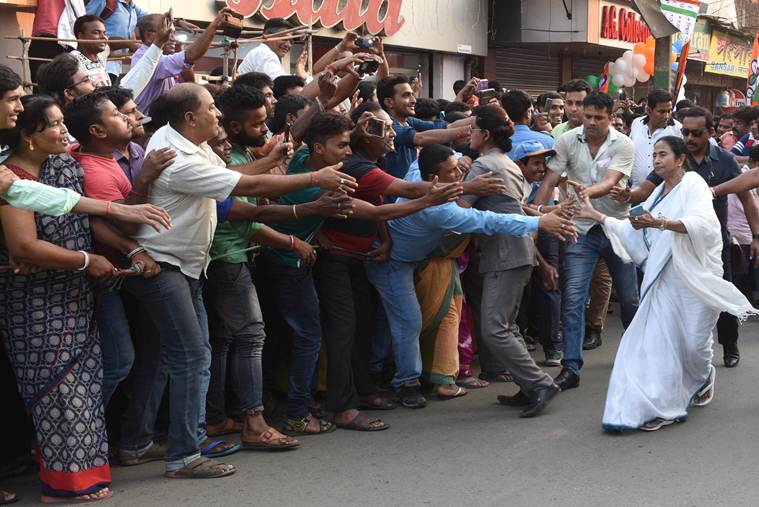 CM Mamata Banerjee during an election campaign in Durgapur, West Bengal. (Express Photo by Partha Paul)
CM Mamata Banerjee during an election campaign in Durgapur, West Bengal. (Express Photo by Partha Paul)






